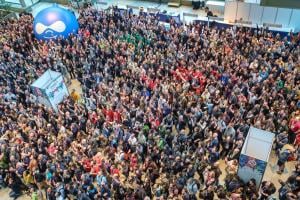
Open Source: A Community and a Culture

Open source software boasts many strengths that draws everyone from freelance web developers to tech giants into the fold. These strengths include flexibility, scalability and accountability, among others. Yet, open source technology also offers organizations something else, which isn’t nearly as easy to quantify — a community. The open source community comprises millions of diverse, passionate developers, designers, teachers and thinkers from around the world who share a set of values. They collaborate in offices and across oceans and on projects big and small, formal and informal, technical and creative.
The open source community holds a fundamental belief that the collective effort of a global community will deliver more and better code, as well as more expansive, creative approaches than that offered by a small team employed by a single organization. Such a team may be more likely to approach problems from the same angle. The open source community’s collective knowledge and expertise provides a wealth of enrichment opportunities for teams who run open source software, as well as the chance to grow with them.
In fact, the open source community is an essential part of the open source movement — without the community, there would not be open source code or the infrastructure to elevate it to its full potential. In this post, we’ll explore some of the values of the open source community as well as some of its greatest achievements.
Values
Openness
Openness is the most obvious value of the open source community, with a lot of layers of transparency. Openness means that any project, no matter how small, can freely compete with any other project, no matter how large. If you can't find what you’re looking for, it doesn’t exist in the open source world. Furthermore, the code must remain open once you use it. At no point can individuals submit proprietary code that they deem “belongs” to them, and neither can they adapt open source code so that it becomes their own work. Furthermore, open source code must remain open to everyone — businesses, individuals and governments — forever.
This of course is a double-edged sword, because openness necessitates access to all coding: just as there is good and bad code, there are users with positive and negative intentions. The open source community relies on the goodwill and maturity of its users and is committed to that relationship.
Transparency
Transparency is a value that offers more than meets the eye. Open source code is inherently transparent, however transparency transcends programming language. Transparency permeates the open source community at every level -- it not only inspires trust between developers across the globe as well as between the greater community and its leaders, it necessitates it. Open source thought leaders believe that transparency fosters innovation, agility and engagement, which are essential ingredients for successful development.
In sum, in the open source world, transparency is embraced as a means of facilitating solutions. In fact, many open source–based companies are publishing not only their code base online, but also financial information such as revenues, profit and employee salaries in the name of transparency.
Consensus
Open source is all about consensus. Directives aren’t given in the open source community. Instead, problems are worked out through collaboration. With consensus comes a shared responsibility that the open source community embraces, promoting an egalitarian approach to coding. The quality of a contribution, rather than a job title or company policy, determines influence and technical direction in the open source community.
This attitude is also borne out in the adoption of code, since open source code is more or less crowd-sourced. When code works, developers will want to use it and built on it. Indeed, the open source community often cites its “mission-driven” approach to software development as a major reason to choose open source software over proprietary rivals, which may be more driven by financial or corporate concerns.
The three values outlined above are broad yet guiding principles for more formal directives. For example, the Open Source Initiative (OSI) has dictated terms and conditions for any project distributed under an open source license, all of which fall under these umbrella values. According to OSI, anyone who wishes to license an open source project must:
- Include all source code in their submission
- Agree to the free redistribution and modification of their code
- Not discriminate against any person or group
- Not restrict the code to specific purposes or fields
- Not place restrictions on other software used alongside the code
- Not predicate their code on any other individual technology or platform
On the Ground
The open source community includes more than web developers. A robust network of organizations exists to promote and support open source values, representing countless countries, industries and missions. Notable organizations include the Free Software Foundation, a nonprofit with a worldwide mission to promote computer user freedom and to defend the rights of all free software users; Open Source Matters, a nonprofit organization that serves the financial and legal interests of the Joomla project; and the Free Software Foundation, a nonprofit corporation formed to educate about and advocate for the benefits of open source and to build bridges among different constituencies in the open source community.
However, some of the most powerful constituencies within the open source community aren’t so formal. For example, Drupal is an open source content management system with a community that many consider second-to-none when it comes to collaboration and support. This community, which comprises millions of members, stays active by contributing to the Drupal codebase, evangelizing on behalf of Drupal, and organizing summits such as DrupalCon, while adhering to Drupal’s code of conduct. Additionally, members of the Drupal Community have joined forces to support initiatives such as Code with a Cause.
Conclusion
“Today, technology is becoming more and more complex and the rate of change is accelerating. It is becoming increasingly difficult for any one organization to build an entire solution and do it well. By contributing back and by working together, these organizations can keep a competitive edge over those that don't use open source and collaborate,” writes Dries Buytaert, founder of Drupal and a widely respected open source visionary. “What looks strange to some, is actually perfectly logical to others. Those that contribute to open source are engaging in a virtuous cycle that benefits their own projects. It is a tide that raises all boats; a model that allows progress to accelerate due to wider exposure and public input.”
This evocative quote illustrates the open source philosophy, which is very much in keeping with the origins of the internet itself as a paradigm of collaboration. The internet of today comprises a continuously evolving amalgamation of countless and diverse applications, machines, programming languages and users — a grassroots effort if there ever was one. The open source movement is purposefully following in these footsteps, with the mission to transform how we think about and develop code. It has clearly succeeded in that mission, and it couldn’t have done so without its community.


